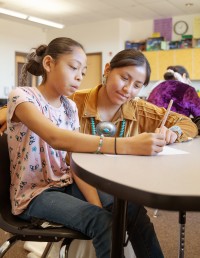With education equity under assault from Trump, new online tool shows how states can close opportunity gaps for students
Data-driven, multi-state dashboard provides valuable insights to help create more supportive and equitable learning environments for students
With the Department of Education facing an uncertain future, so too does much of its research and data collection around inequities based on race, poverty status, and disability status. A newly launched online resource helps fill this critical gap by providing a first-of-its-kind, multi-state examination of the many factors that impact opportunities to learn — providing valuable insights and data points for parents, educators, and others to create more supportive learning environments.
The Opportunity to Learn Dashboard, developed by the National Center for Youth Law (NCYL) and the Schott Foundation for Public Education, explores a total of 18 in-school and out-of-school factors that affect opportunities to learn for students in 16 states. The online tool, which provides downloadable deep-dives into each state's data, highlights how things like resource inequity, unjust school discipline policies, and even access to food can significantly impact the ability for students to learn and thrive. It also uses data to identify racial disparities and how they impact learning opportunities in each of the included states, and makes recommendations to improve equity and increase students' opportunities to learn.
"Awareness of this information is critical to ensure that every student has equitable access, which means 'fair access' to opportunities to learn," said Dan Losen, NCYL's Senior Director of Education. "We're thankful for the Schott Foundation for Public Education for its commitment to spreading awareness of these issues and for their collaboration with NCYL toward ensuring that students' learning opportunities and experiences are prioritized."
"These profound inequities in students' opportunities to learn must not be hidden from public view. As a society we must do more to level the playing field and push back on the current federal administration’s divisive, anti-equity, and anti-civil-rights agenda," Losen added. "In this time, the highlighted factors will help schools and districts make more fair and lasting improvements to schools that will benefit all students and society as a whole."
The states examined include Arkansas, California, Connecticut, Florida, Georgia, Kentucky, Louisiana, Maine, Massachusetts, Mississippi, New York, North Carolina, Pennsylvania, Rhode Island, Tennessee, and Texas. In analyzing data for the dashboard, NCYL found that:
- In North Carolina and Kentucky, nearly one in four Black students with disabilities were suspended out of school in 2023. These rates were 2 to 3 times higher than the rates of their white peers.
- In Texas, while 11.2% of white students received the benefits of enrichment in “Gifted and Talented” courses, only 4.2% of Black students benefited from this enrichment.
- California has a 36-point gap between white and Black students on the NAEP 8th grade math exam and a 24-point gap between white and Black students on the NAEP 8th grade reading exam. That gap in math scores is larger than the national average.
- Tennessee ranks 36th out of 50 states plus Washington D.C. in per-pupil spending, signaling room to improve its investment in education.
- In New York, the graduation rate for Black students (81%) is significantly lower than the rate for white students (92%), suggesting disparities in opportunities to learn.
- Approximately 30.3% of children in Mississippi live in a food desert.
- Black children in the U.S. are more than twice as likely as their white peers to experience childhood poverty. Massachusetts has the lowest overall childhood poverty rate (11.5%), while Mississippi has the highest (26.4%). Mississippi also has a large gap (22.9 percentage points) between the percentage of Black and white students experiencing poverty.
Users can examine these and other inequities that impact learning within each state analyzed for the dashboard.
External factors include things like living in poverty or having access to health insurance and housing. School factors include district and school spending priorities, including teacher pay, and access to challenging curriculum and mental health supports.
This data should be used by policymakers and education leaders at the state and local levels to improve supports and ensure students have equitable opportunities to learn. Equity equals fairness, so raising awareness of these issues and being vigilant in finding solutions is paramount, particularly at a time when federal civil rights enforcement agencies are attacking the very concept of equity.
Among the recommended actions: State and local districts should collect and annually publish data related to these opportunities to learn, and that information should be provided to community members to track changes to these indicators over time. The Education Civil Rights Alliance (ECRA), a coalition convened by NCYL, also recently made several more recommendations in letters sent to state leaders across the nation, including a call for state agencies to bolster their efforts to address inequity and protect children from disparities caused by unlawful discrimination.
The new Opportunity to Learn dashboard can also be used to see where progress is being made and/or to provide a starting point for making comparisons between states. We must collectively work to eliminate these inequities to improve public education, not use them to abandon or minimize public education.
"In light of the current attacks on public education, on democracy, on equity, and on social justice, these resources fill a critical and increasing void for advocates, students and ordinary citizens who expect a public education system that is maximally responsive and that advances basic democracy,” said Michael Wotorson, National Program Director with the Schott Foundation for Public Education.
###
The National Center for Youth Law centers youth through research, community collaboration, impact litigation, and policy advocacy that fundamentally transforms our nation's approach to education, health, immigration, foster care, and youth justice. Our vision is a world in which every child thrives and has a full and fair opportunity to achieve the future they envision for themselves.
The Schott Foundation for Public Education is a national public fund that supports racial & education justice movements and promotes equity & opportunity in public education. Schott also advances the struggle for equity and justice in public education with research convenings, grant support to the field, and through inclusive communications strategies. For more information, visit www.schottfoundation.org.



